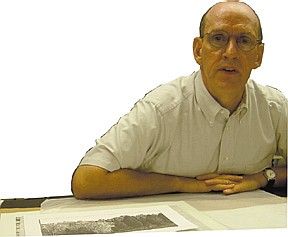Doing something halfway or part-time typically
produces a result that is itself but half-baked.
But for the well-regarded local painter Tom
Keesee, working part-time has paid off in
full.
The 50-year-old adjunct professor of art at the
University of Saint Francis has quietly developed
a gallery of admirers of his work created during
the other half of his days during the past 23-odd
years.
In the period before USF, the ingratiating
Keesee worked for three different museums as an
installation specialist, arranging, mounting and
hanging exhibits. After earning his MFA from
Miami University in Ohio, he launched this
curious vocation at the Indianapolis Museum of
Art (It was there that he first met his wife,
Dee, a Fort Wayne native who managed the
institutions textile holdings.) After this
initial stint, the couple moved out east to
Purchase, New York where Tom found a similar
position at the Newberger Museum, which is a part
of the SUNY system.
Not long after, however, Dee longed for her
family in the Fort, and the couple settled here.
Almost immediately, Keesee found an opening at
the Fort Wayne Museum of Art, where he remained
for five years until then college department
chair Maurice Papier recruited him to teach a
decade ago. Throughout this period the Keesees
have served in several capacities at Artlink.
Known widely for his accomplished prints in
which he deftly renders nature scenes and
landscapes, Keesee’s oil thickly impostoed
landscapes are equally prized. His work has been
featured at the university, the Allen County
Public Library and at several private local and
regional galleries, including Indianapolis. Three
super-sized oil landscapes are scheduled to
anchor Betty Fishman’s “Growing Up in Indiana”
exhibition set for an August 20th opening at
Artlink.
Born into a Crawfordsville family construction
business, Keesee worked summers as a rough
carpenter and, after graduating from the John
Herron School of Art in Indianapolis with a BFA
in 1977, he returned to the same work for two
years before deciding to pursue a master’s
degree.
“There’s no greater motivation to return to
school than the day-after-day labors of
construction,” Keesee recalled recently. “We’ve
been fortunate to be able to have found work in
our fields. We’re lucky too to be around other
artists, and I totally enjoy working with the
students.
“It’s fun and rewarding to watch them grow,
whether they stay with printmaking, painting or
something else. I’m not a Luddite but my tools –
inks, acids, scribes, pigments and bristle
brushes are associated with bygone years, not the
high tech of computers. The print department here
at USF is exceptional. Art Cislo is a master and
a great teacher, treasure for the students.”
Keesee has already completed his contribution to
the Artlink show and has since concentrated on a
showing scheduled for February 2005 at Saint
Francis that promises to be a breakout – a shift
from the subtle energy of his oil winter
landscapes to scenes of raw power and bold
action.
These evolving works are a major departure in
scope, style and methodology of the mild-mannered
painter and are certain to cause some
consternation amongst his longtime followers and
those familiar with his work over the years.
Swabbing, dabbling, dripping, streaking abstract
fields of color are worked onto a pair of three
by four-foot canvases, then mounted in diptych
fashion. These are not your grandmother’s parlor
landscapes.
Keesee, following the lead of the alchemists,
has developed a unique process for arriving at
these newimages that reflects his experimental
nature. Seldom satisfied to sit long in any one
place or stick to a particular style, Keesee has
always pushed his considerable talents in new
directions.
In this case the painter couples his rich
imagination with plenty of blank sheets of paper
and begins a regime driven sometimes by chance
and intuition in a kind of automatic,
free-association writing.
From these dozens and dozens of studies Keesee
mines inspiration and sometimes surprises. Most
are abstract, biomorphic patterns about color and
shape, but others can be seen as sunflowers or
zinnias, and still others seem sculptural, even
architectural in form.
Using these pieces as fuel, the painter then
assumes the challenge of the larger canvases, one
at a time.
“I’ll begin with one,” Keesee explained.
“working it to a point where I’m somewhat
content, then I’ll turn it to face the wall and
begin with the second so as not to be too greatly
influenced by what I’ve already done. In the end,
when finished, something happens when they are
placed together.”
Sounds a bit bizarre perhaps, but it isn’t
really when you see the results. There is a kind
of synapse that occurs between the two panels and
I suspect that is Keesee’s realm of
exploration.
In the process, this tension between nature and
artifice becomes fundamental. Alchemy, as
revealed in a recently released study “Promethean
Ambitions” by IU professor William Newman is
“primarily an art of transmutation: one metal is
turned into another, one living creature erupts
out of the substance of another. Alchemy is
concerned with the character of that change. It
thus pays attention to categories, differences
and boundaries.”
Following such a description, Keesee’s newest
works seem to parallel this ancient art/science
and poses questions like, “If one substance is
changed into another, does it change its essence
or only some of its properties? Is nature being
revealed or overturned?”
All in all it is a major departure for the
artist and one that promises to surprise admirers
old and new.
 Submit Your Event
Submit Your Event
